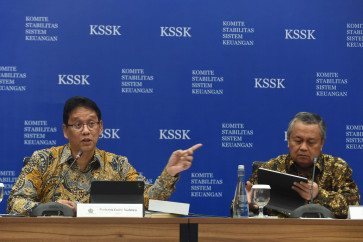Popular Reads
Top Results
Can't find what you're looking for?
View all search resultsPopular Reads
Top Results
Can't find what you're looking for?
View all search resultsIRRI global center for rice innovation
Hi-tech breed: A rice variety developed by the International Rice Research Institute (IRRI) ripens on its 200-hectare experimental farm in Los Banos, the Philippines
Change text size
Gift Premium Articles
to Anyone
H
span class="caption">Hi-tech breed: A rice variety developed by the International Rice Research Institute (IRRI) ripens on its 200-hectare experimental farm in Los Banos, the Philippines.(JP/Corry Elyda)
Cruising into the 200-hectare compound of the International Rice Research Institute (IRRI) in Los Banos, a two hour-drive from Manila, on a recent afternoon invoked a distinct sense of déjà vu. The clear blue sky and the lush green paddy fields with hills as the backdrop were reminiscent of typical farms in the villages of Central Java or West Sumatra.
That day’s tour facilitated by the agriculture companies association, CropLife, to the famed research complex started at the TT Chan Genetic Resources Center, a modest building where a rice-gene bank is housed. There, the institute keeps 129,000 genes of rice from more than 120 countries.
The collection includes wild rice, ancestor rice, traditional rice, heirloom rice, modern varieties and a host of other varieties that the center’s head, Flora C. De Guzman, called “elite breeding lines.”
“The gene bank can keep the seeds for 50 to 100 years,” she said.
Cofounded by the Ford and Rockerfeller foundations and the Philippine government in 1960, the IRRI has become an international center for research and development of rice — the staple food of more than 3.5 billion people worldwide.
The first cool storage with a temperature of 2 to 4 degree Celsius stores rice seeds that are ready for delivery upon request.
“Farmers and researchers may request seeds,” Flora said. The IRRI gives out only 10 grams of each seed because it keeps only 0.5 kilograms of each variety.
As safety precaution, the IRRI also keeps duplicates of seeds in other gene banks in Colorado, the United States, and Norway
While the gene bank focuses on preserving rice, the Transgenic Research Facility in the compound develops new varieties. One of the IRRI’s cutting-edge innovations is “golden rice,” a transgenic rice variety claimed to be rich in beta-carotene, a precursor of Vitamin A.
Although the golden rice is still in its experimental stage, it has already sparked controversy. Critics are suspicious that its development is chiefly driven by business motives and the seeds will be monopolized by well-connected companies. Others question the wisdom of developing beta-carotene rice instead of, for instance, educating people on the need to plant and consume carrots.
Besides the golden rice, the IRRI has also been developing other rice genes, such as the C4 that scientists outside the IRRI say has the capacity to supercharge photosynthesis and boost production.
“Other than that, we are also developing rice grains with enriched content of iron and zinc to fulfil consumers’ need for micronutrients,” Rizza Eve S. Mendoza, head of the IRRI’s biological safety risk management and quality assurance, said.
The IRRI focuses on putting other micronutrients into rice grains on the grounds that residents in many rice-consuming countries have been suffering from “hidden hunger,” or a lack of micronutrients, as they can only meet their calorie needs, but not the need for other essential vitamins and minerals.
But make no mistake. Nutrients and high yield are not the only focus; the IRRI also considers taste in its products. So it has set up a Grain Quality and Nutrition Center (GQNC) that studies and develops texture, taste, color, shape and quality.
“We are trying to make sure that the varieties we develop have the health benefits and at the same time capture consumers’ preferences,” GQNC chairman Nese Sreenivasulu said.
Creating new high-quality varieties is the IIRI’s main mission as part of the 1930s-1960s global “Green Revolution.” The institute is notable for its successful creation of new varieties. Yields have increased from 1.5 tons per ha in the 1970s to more than 4 tons nowadays.
New superior rice varieties are vital as the global population continues to rise while arable land rapidly decreases. Among its latest work are flood-resistant rice genes that have been widely cultivated in India.
Another great thing about the institute is that certain quarters are open not only to researchers but also to the general public. The rice museum offers a glimpse of how rice farming has evolved around the world.
The museum features traditional rice-farming tools, like the traditional plough from China, wooden rice huller, winnowing fan (a tool to separate straw, chaff, bran and other foreign materials from the rice), sickle, harvest blade and ear-cutting rice knife. Some of the tools are still widely used in countries like Indonesia, China and India. Also on display are rice products, such as rice wine, noodles, crackers, biscuits, oil and milk.
_______________________________
Disruptive innovations
* First wave: Green Revolution technologies of improved seed, fertilizer, pesticides, irrigation and mechanization
* Second wave: Biotechnology
* Third wave: Digital - Biological integrated technologies
- “Agtech”- KIA, digital revolution,4th Industrial Revolution, Biotech revolution
- “Fintech”
* Fourth wave: Food without agriculture










